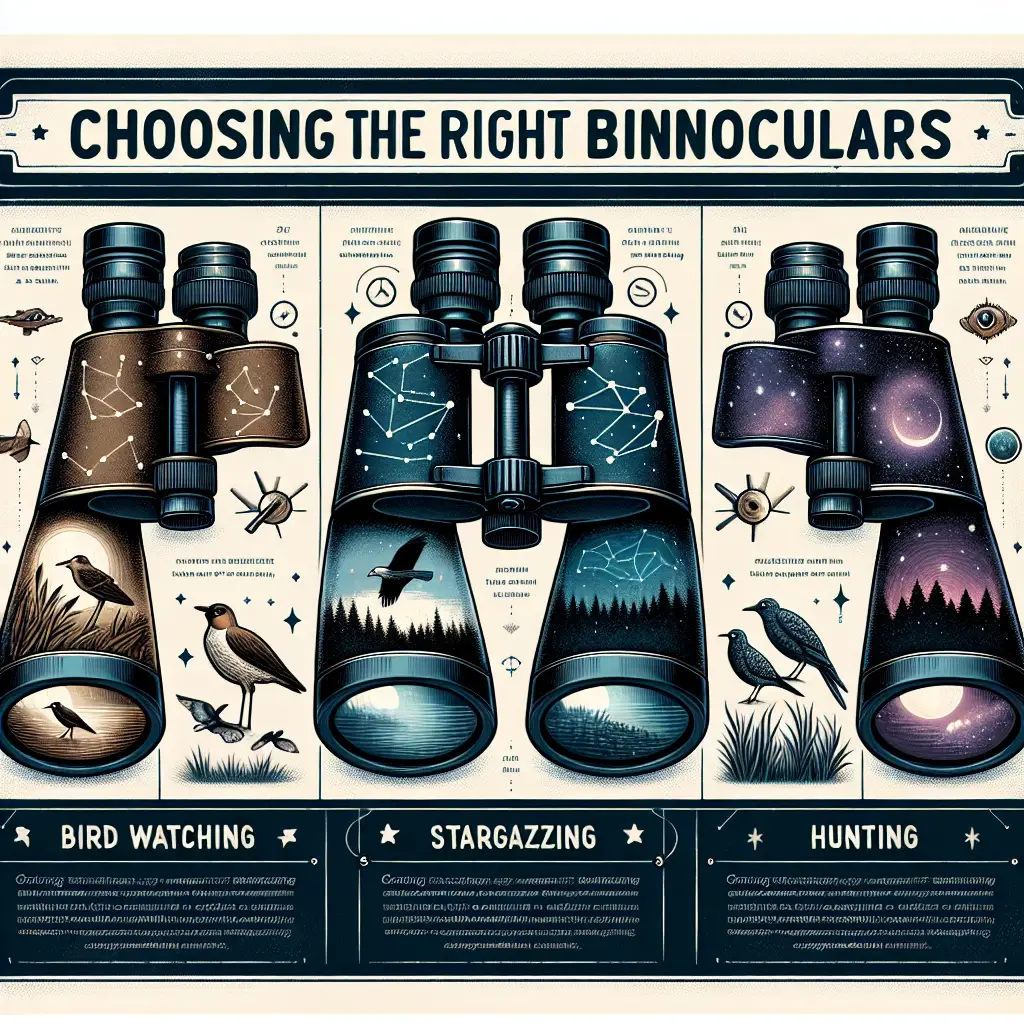Title: Choosing the Right Binoculars for Bird Watching, Stargazing, and Hunting
If you’re an outdoor enthusiast, investing in a good pair of binoculars can enhance your experiences, whether you’re admiring the delicate features of a bird, gazing at the stars, or tracking game. But with a market flooded with options, how do you choose the right pair for your specific needs? Let’s focus in on the critical factors you should consider when selecting binoculars for bird watching, stargazing, and hunting.
Bird Watching Binoculars: Clarity and Color Fidelity
Bird watching is an activity where details like feather texture and color variations are crucial. For this reason, binoculars with high-resolution optics are non-negotiable. You’ll typically want a magnification of 8x or 10x – the former offers a wider field of view while the latter brings you closer to distant birds. An objective lens size of 42mm is a good balance between light-gathering capability and portability.
Consider the Nikon Monarch 5 8×42, which provides crystal-clear imagery and accurate colors, crucial for identifying small and distant birds. The ED (Extra-low Dispersion) glass ensures sharpness and a wide field of view, making them ideal for birders.
Furthermore, look for binoculars with good close focus capability — the shorter the close focus, the better you can see details in birds that are nearby. Roof prism models are generally more lightweight and compact, which is an advantage when you’re out in the field for extended periods. Check trusted bird watching communities and organizations, like the Audubon Society, for recommendations and reviews tailored to birding binoculars.
Stargazing Binoculars: Aperture and Stability
When you turn your gaze skyward to lose yourself amongst the stars, the key feature of your binoculars should be a large aperture – the diameter of the objective lenses. A larger aperture allows more light to enter, making celestial objects like stars, galaxies, and nebulae more visible. Binoculars in the range of 15×70 or 20×80 are preferred among stargazers.
The Celestron SkyMaster 15×70 Binoculars are an excellent choice for amateur astronomers. They have a large 70mm aperture to capture celestial sights and multicoated lenses to enhance contrast.
For stargazing, you also need binoculars that can be mounted on a tripod. The images of stars and other celestial bodies can be shaky due to the high magnification, and a tripod ensures a stable view. Be sure to check out astronomy sites like Sky & Telescope for expert advice on astronomy binoculars and how to use them.
Hunting Binoculars: Durability and Low Light Performance
Hunting often involves traversing rugged terrain and dealing with harsh weather conditions. Therefore, durability should be a top priority. Look for binoculars labeled as waterproof and fog proof. Multi-coated lenses are a must for hunting binoculars as they maximize light transmission, improving visibility in low light conditions typical during dawn and dusk when many game animals are most active.
A popular magnification for hunting is 10x, providing a good balance between size and power, though some hunters may prefer the wider field of view of an 8x binocular for tracking moving game. An objective lens size around 42mm is sufficient for most hunting applications, offering a good compromise between light-gathering capability and portability.
Rubber armor coating is another feature to consider for hunting binoculars – it provides a secure grip and added protection from drops and bumps. Check out hunting forums or credible sources like Outdoor Life that regularly review and rank hunting binoculars.
Understanding Binocular Specifications
Binoculars are typically described by two numbers, for example, 10×42. The first number denotes the magnification, or how many times closer objects appear than they are. The second number is the diameter of the objective lenses in millimeters, which determines how much light the binoculars capture. Remember, the larger the objective lens, the brighter the image but also the heavier the binoculars.
Further Considerations
Regardless of your outdoor pursuit, pay attention to the practical features like the binoculars’ weight, eye relief (especially important if you wear glasses), and field of view. But also, consider the warranty and after-sales service because even the highest quality binoculars can encounter issues down the line.
Now that we’ve scoped out what to look for, it’s up to you to pick out the pair that best suits your outdoor adventures. Be sure to handle various models and test them in conditions similar to your typical use. Local sporting goods stores can be a great place to start, but don’t forget about the wealth of knowledge available on specialized blogs and websites.
Choosing the right binoculars involves balancing various factors, from optical quality and magnification power to durability and portability. Whether you’re a birder, stargazer, or hunter, there’s a pair of binoculars built for your needs. Happy viewing!


